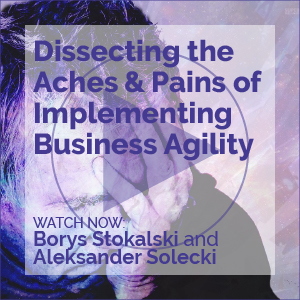ERP Projects -- Part II: Prices, Pain, and Benefits
RFID: Coming Soon to a Supply Chain Near You
RFID: Coming Soon to a Supply Chain Near You
Scaling Agile Processes -- Part IV: Too Large Teams
Radical Requirements
Enterprise IT Maturity
The OMG and Web Services
Planning for "Go Live"
Many development project schedules I see end with a triumphant milestone activity called something like "Go Live." Note that I said "end with," not "include."
Is All Information Technology a Commodity?
Nicholas Carr's article, "IT Doesn't Matter," in the May 2003 issue of the Harvard Business Review, continues to generate a lot of heated discussion because of its thesis, which basically proposes that information technology is becoming so commonplace that it really doesn't offer companies much strategic advantage. Carr covered a number of issues associated with the commoditization of IT, but the following quote gives a pretty good idea of where he is coming from:
Is All Information Technology a Commodity?
Nicholas Carr's article, "IT Doesn't Matter," in the May 2003 issue of the Harvard Business Review, continues to generate a lot of heated discussion because of its thesis, which basically proposes that information technology is becoming so commonplace that it really doesn't offer companies much strategic advantage. Carr covered a number of issues associated with the commoditization of IT, but the following quote gives a pretty good idea of where he is coming from:
Managing Technology Decisionmaking
Even More Extreme Project Management -- Part 5, Analyzing and Managing Stakeholders, Part 3
Extreme Project Management
There are three major forces driving the need for a new paradigm of project management.
Driving force 1: a power shift. The use and abuse of expert power by people in IT has resulted in a major shift of the control within the industry back into the business areas. In most organizations, there has been a dramatic increase in the amount of business experts' involvement and ownership in the project development process and its management.
Where Did Everyone Go?
Where Did Everyone Go?
Academic Partnerships for IT
Six Sigma and Software Development
Enterprise Applications Soap Opera
Framework Class Libraries
Don't Feed the Monkeys
There is a carving above the portico of the 17th century Japanese mausoleum of the shogun Tokugawa Ieyasu. In this carving are depicted three wise monkeys in the representation of a sacred stable: Mizaru who covers his eyes and sees no evil; Mikazuru who covers his ears and hears no evil, and; Mazaru who covers his mouth and speaks no evil.
Don't Feed the Monkeys
There is a carving above the portico of the 17th century Japanese mausoleum of the shogun Tokugawa Ieyasu. In this carving are depicted three wise monkeys in the representation of a sacred stable: Mizaru who covers his eyes and sees no evil; Mikazuru who covers his ears and hears no evil, and; Mazaru who covers his mouth and speaks no evil.
Enterprise Applications Soap Opera
Enterprise Applications Soap Opera
The Value Equation for Agile Project Management
In today's -- we hope -- improving economy, business executives are interested in getting the greatest value for their expenditures and in reducing overall costs. With the emphasis on innovation and creativity, we sometimes lose sight of the fact that agile project management and software development (APMSD) can have a dramatic impact on the bottom line.
Keeping the Enterprise's Right Brain and Left Brain in Sync
During the 1980s, my biggest client was a telephone company. I remember one day talking to a top executive with this company about what he considered to be his most serious technology problem. He didn't even think about it, he just blurted out: "The billing system by a long ways. We can create new telecommunication products much faster than we can figure out how to bill for them."




